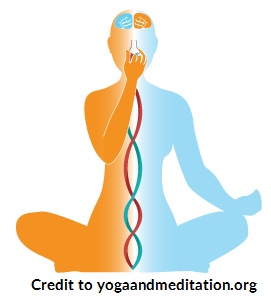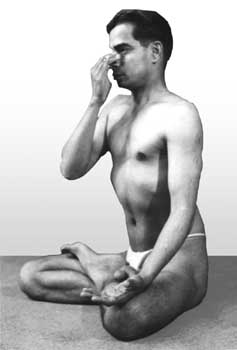Post By: Vishwanath Iyer Published on: December 28, 2016 Reading time: 7 minutes

It is important to understand nāḍī when practicing prāṇāyāma. Subtle energy channels (nāḍī) and vortices (cakras) within the body which act as conduits of motility (prāṇa) and impact the physical, emotional and intellectual well-being of the practitioner.
At the mūl̄adhāra, the junction of the idā, pingala and suṣumṇā-nāḍī are called yuktā-triveni (yuktā = combines + tri = three + veni = streams). When they meet again at the ājñā-cakra, they are called muktā-triveni (muktā = liberated three streams).

Yogacharya Sundaram performing prāṇāyāma is the 1920’s
A – Pūraka (inhalation): A single inhalation is termed pūraka. It is a process of drawing in air or inhalation. Also, it should be smooth and continuous. Breaks in pūraka must be eliminated with practice.
B – Abhyantara-kumbhaka (hold after inhaling): kumbhaka consists of deliberate stoppage of breathing and retention of the air in the lungs after inhalation.
C – Recaka (exhalation): The third stage, exhalation, is called recaka. Like inhalation, it too should be smooth and continuous, though often the speed of exhaling is different from that of inhaling. But attempts should be made to keep pace, quality and flow of exhalation equal to inhalation.
Normally, when inhaling, the abdominal wall descends, drawing down the viscera and stretching it. During kumbhaka, breath is held and this exerts a strain on the abdominal wall. During recaka, the wall is relaxed and collapses inward, pushing the viscera against the diaphragm, emptying the lungs.
D – Bāhyā-kumbhaka (hold after exhaling): The fourth stage, the retention of breath after exhaling, is called bāhyā-kumbhaka.
The fourth stage completes the prāṇāyāma cycle when the retention ends and a new inhalation begins.
A – Ārambha-avastha (starting state) – In this stage, prāṇa is stabilised within the body. The various vāyus (airstreams) such as (prāṇa-vāyu / apāna-vāyu / vyāna-vāyu / udāna-vāyu / samāna-vāyu) are balanced. When a person practices prāṇāyāma sincerely, the following changes occur;
B – Ghata-avastha (pot state or gathering state)– This is the second stage of prāṇāyāma. This occurs when there is constant suppression of breath. Then, there is a perfect union of prāṇa-vāyu and apāna-vāyu, manas (cognition) and buddhi (logic). Here, the yogi experiences sama-drishti (viewing all creation equally). Also, the yogī experiences clairvoyance, telekinesis, erudition, ability to become invisible and take up any form he desires.
C – Parichaya-avastha (acqaintance state) – Vāyu or breath-flow, pierces the kundalini, which along with agni, enters the suṣumṇā and merges with it. At this stage, the yogī’s karma is destroyed. The yogī is able to see and manipulate prāṇa.
D – Niṣpatti-avastha (consummation stage) – Here, the yogī’s identity merges with the universal identity and all cycles of birth and death are burned away. This is the final state and is also called samādhi, mokṣa.
There are many techniques such as sama-vṛtti (even condition), visama-vṛtti (uneven condition), śītalī (tongue curled between the lips), śītkārin (tongue curled between the teeth), udgīta (prāṇāyāma with chanting). However, the following schedule is adequate to meet daily requirements;
| Prāṇāyāma | Cycles | Benefits |
| Nāḍī-śuddhi with kumbaka | 5-20 | Overall lung functioning, balancing of left/ right brain, balancing of idā and pingala-nāḍī. |
| Bhastrikā | 5-20 | Increases lung capacity, transfer capacity, activates dead alveoli, increases lung elasticity and strengthens diaphragm. |
| Kapālabhātī | 25-100 | Increases volumetric efficiency of the lungs, strengthens the trachea and all pulmonary vessels. Strengthens the abdominal walls. |
| Ujjayi | 3-6 | Improves the autonomous nervous system, the heart, clears ears and sinuses. |
| Bhramari | 3-6 | Opens the nasal passages, clears all the sinuses, removes mucous. |
| Nāḍī-śuddhi | 5-10 | Close with nāḍī-śuddhi to reset the system. |